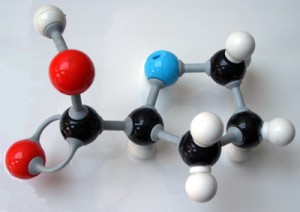
Atoms combine to form molecules. Atom A approaches atom B and cohesively attaches to it. Molecule AB is held together by a chemical bond.¹ That bond is written A–B, or in the case of multiple bonds, A=B, A≡B, etc.
Factors in Bond Formation
The primary bonding agency is electrostatic force. This is the force between electrical charges. A positive charge is due to a lack of one or more electrons, producing cations. A negative charge is due to an excess of electrons, producing anions.
One of the simplest examples is the formation from sodium (Na) and chlorine (Cl) of ordinary table salt, sodium chloride (NaCl).² We write,
Na – e⁻ → Na⁺
Cl + e⁻ → Cl⁻
Na⁺ + Cl⁻ → Na–Cl
The first equation says take away an electron and get a sodium cation. The second says if an electron is added to a chlorine atom, a chlorine anion results. A sodium cation combines with a chlorine anion to make neutral sodium chloride.
Discussion: sodium chloride retains both its positive and its negative charges. This kind of bond is called ionic.³ The charges are separated by the bond’s length. The molecule is polar. It has both positive and negative poles. Still, the net charge is zero. The molecule as a whole is neutral.
The Nature of the Chemical Bond
What is the precise nature of the chemical bond? It does matter. Understanding allows us to predict how substances interact. This makes it possible to devise steps that lead to a specific compound. Say a new drug to treat heart disease.
No one has seen a chemical bond. This should be no surprise. After all, can one see a force? Yet a study of all sorts of bonds helps us develop intelligent models.
Chemical Bond Models
There are two major bond models. Some atoms appear to give up or receive an electron to form a molecule. This is the ionic model. This model works well for sodium chloride. But for many compounds this model does not suffice. A different model is needed, the covalent model. Covalent bonding requires one or more electrons are shared.
Often, something between these “extremes” is a better fit. Electronegativity fills the gap.
Electronegativity
Most bonds lie somewhere between ionic and covalent. Nobel Prize winning chemist Linus Pauling is credited with the concept of electronegativity.
Some elements are highly electronegative. They are “hungry” for electrons. Especially is this true of fluorine. An atom of fluorine becomes the negative F⁻. Highly electronegative elements “snatch” electrons from other atoms.
At the other end of the spectrum, some atoms easily give electrons away. An example is the alkali metal cesium. It becomes the positive Cs⁺. Other elements lie between these extremes.
Macroscopic Physical Models
To aid in understanding, various macroscopic models were developed. The crudest of these is the stick model, with two spherical balls joined by one or more sticks. The length of the stick represents the length of the bond. Bonds do maintain a set length and directionality. But the stick model lacks flexibility.
Another model is the spring model. When atoms in a molecule are excited, bonds lengthen or shorten. Atoms are pushed out of ideal alignment. But the bonds remain intact. There may be symmetrical stretching, asymmetrical stretching, scissoring, rocking, wagging, and twisting.
What is the Point?
The point is there is some degree of rigidity to a chemical bond. There is some degree of ionic character. Some degree of covalent character. Electronegativity helps explain some of this.
This article provides a very basic introduction. There are other models, including the Valence Bond (VB) and the Molecular Orbital (MO) models. Hopefully the above presentation helps the reader develop a feel for what goes on at the molecular level.
1 There are other associations of atoms, such as those due to Van der Waals forces, not considered here.
2 Chlorine gas most often exists as the diatomic Cl₂.
3 There are a number of bond classes, such as ionic, covalent, and metallic.
Note: You might also enjoy Which Chemical Bond is Stronger: Ionic vs. Covalent Bonds
References:
- The Free Dictionary: Cohesive (2nd definition)
- Southern Illinois University McCoy Library: Chapter 9: Models of Chemical Bonding
- Wired Chemist: Valence Bond and Molecular Orbital Models
← Back to Classic Science
← Home